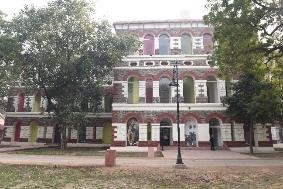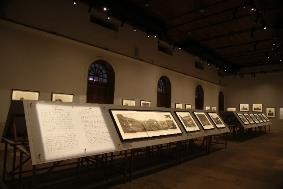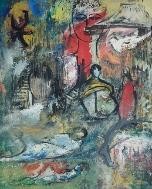The Red Fort was the Mughal seat of power till 1857, when during the first war of Independence, the last emperor, Bahadur Shah Zafar was unseated from the throne and exiled. The British then occupied the Fort, turning it into a garrison. Most of the palaces and pavilions built by the Mughals were destroyed and the barracks were built for the British Army. Following Independence, the Indian Army was based in these barracks till 2003. In 2007, post the declaration of the Red Fort as an UNESCO World Heritage Site, the barracks have been renovated, restored and turned into museums.
Drishyakala, in Barrack Number 4, is an extraordinary visual arts showcasing, one that not only highlights a part of India’s historical trajectory but also provides a valuable glimpse of the diverse panoply of Indian art. Through four iconic exhibitions with over 450 artworks spread over 27,000 square feet, DAG maps the complex trajectory.
- The seafaring Europeans commissioned artists as early as the eighteenth century to come to India so they might carry back artistic renditions of the land and its people to the countries from which they had sailed. The result was the first physical likenesses of people and places painted in a realistic style using such mediums as oil and canvas. Oriental Scenery: Aquatints of India by Thomas Daniell and William Daniell, curated by art historian Giles Tillotson, brings this alive as they depicted Indian architecture and landscape through their travels across India.
- Indian ateliers were quick to seize the moment, and indigenous artists learnt from observation to work with these alien, exotic mediums to cater to a diversifying patronage. A Portrait of Our People, curated by Pramod Kumar KG, captures a changing India through its people. In this exhibition, in pen and ink, paint and canvas, print and paper and all manner art, we seek to understand a portrait of our people and the remarkable times they lived through.
- The emergence of an indigenous printing industry, along with the entry of art school graduates into art as a professional enterprise, gave rise to a new brand of bazaar art in the early twentieth century, spearheaded by the prints of Raja Ravi Varma, Bamapada Banerjee and others. Popular Prints & the Freedom Struggle, curated by Paula Sengupta, showcases how printmaking, or the art of the printed picture, became a tool to illustrate a new brand of nationalist literature while, at the same time, also a means to reproduce paintings made by the emerging orientalist artists of the time, leading to wider dissemination of an emerging nationalist ideal for popular imagination to subscribe to.
- Self-taught artists began giving way to schooled artists, and though they mastered the tools and techniques of their new masters, they were averse to moving too far from their roots. India’s art tradition had been rendered subservient to a Western-oriented approach as taught in the art schools from the mid-nineteenth century onwards. Artists, now, adopted it to contextualise, first, her own history and mythology, and then localise it in a vernacular that found recognition and empathy among its Indian viewers. Navratna: India’s National Treasure Artists showcases India’s nine National Treasure Artists—Raja Ravi Varma, Rabindranath Tagore, Amrita Sher-Gil, Nicholas Roerich, Abanindranath Tagore, Nandalal Bose, Gaganendranath Tagore, Sailoz Mookherjea, Jamini Roy—who together represent a diversity of art traditions and movements but are unified by one common thread: a return to Indian roots through context, theme, subject and an engagement with identity.
With the aim of maximum outreach at its core, DAG has also created small tactile galleries—The Inner Eye: Art for the Visually Impaired—on each of the three floors. Tactile artworks are accompanied by artwork text—in Hindi and English— in Braille. In addition, there is a dedicated space for children—‘Every Child is an Artist’: The Learning Hub—which will has regular programming—workshops, curated walks, poetry sessions—for schoolchildren of all ages and college students.
28.6561592, 77.2410203


The outside façade of Drishyakala Museum that is housed in the renovated British barracks of the Red Fort.

On the ground floor of the museum is Navratna- India’s National Treasure Artists’. The exhibition showcases the art works of Raja Ravi Varma, Abanindranath Tagore, Gaganendranath Tagore, Rabindranath Tagore, Nandalal Bose, Jamini Roy, Amrita Sher-Gil and Sailoz Mookherjea

On the second floor of the museum is a large exhibition of 144 aquatints made by artists Thomas and William Daniell. These were one of the first realistic style paintings of the people and places in India. The Daniells traveled in India between 1786 and 1793.

The very first plate of Oriental Scenery depicts the stately eastern gate of Delhi’s Jami Masjid, the entrance traditionally used by the Mughal emperors. The grand scene is enlivened by the cavalcade rushing across the foreground.

This seated cat is painted in Jamini Roy’s trademark style. The cat gazes at the viewer, it appears calm and seems to swish its tail. The animals that Roy painted were not realistic and he infused his subjects with energy through the bright colors.

Working on the theme of the struggle for independence and its consequences, Sailoz Mookherjea has shown the convergence of various violent non-violent and violent movements coming together to attain a common goal.

This remarkable portrait captures an almost prepubescent boy wearing formal clothes that were popular among royalty in the mid-twentieth century.

In this print, the Panchkanya or Five Maidens—Ahilya, Draupadi, Sita, Tara, and Mandodri—considered destroyers of great sins, are portrayed together through artistic license not offered in the oral storytelling tradition.

Drishyakala has dedicated space, The Learning Lab for children to explore their creativity and learn more about art.

Drishyakala’s outreach department has conducted numerous workshops for children from various schools and NGOs as well as developed programmes for the visually impaired in the tactile galleries of Drishyakala.
